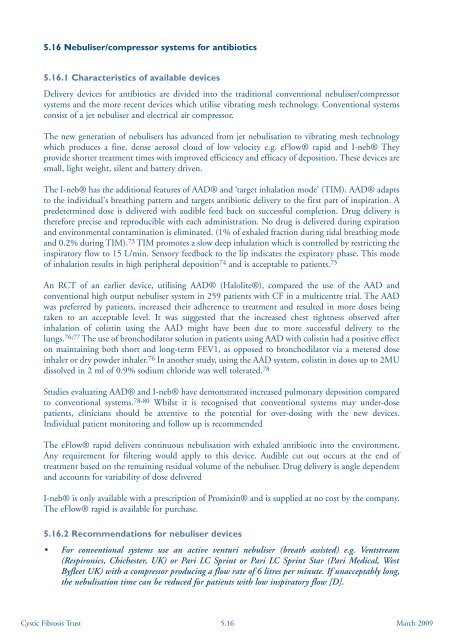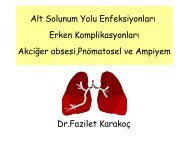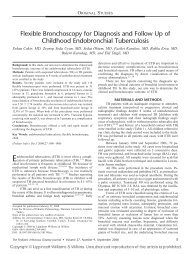5.16 Nebuliser/compressor systems for antibiotics5.16.1 Characteristics <strong>of</strong> available devicesDelivery devices for antibiotics are divided into <strong>the</strong> traditional conventional nebuliser/compressorsystems and <strong>the</strong> more recent devices which utilise vibrating mesh technology. Conventional systemsconsist <strong>of</strong> a jet nebuliser and electrical air compressor.The new generation <strong>of</strong> nebulisers has advanced from jet nebulisation to vibrating mesh technologywhich produces a fine, dense aerosol cloud <strong>of</strong> low velocity e.g. eFlow® rapid and I-neb® Theyprovide shorter treatment times with improved efficiency and efficacy <strong>of</strong> deposition. These devices aresmall, light weight, silent and battery driven.The I-neb® has <strong>the</strong> additional features <strong>of</strong> AAD® and ‘target inhalation mode’ (TIM). AAD® adaptsto <strong>the</strong> individual's breathing pattern and targets antibiotic delivery to <strong>the</strong> first part <strong>of</strong> inspiration. Apredetermined dose is delivered with audible feed back on successful completion. Drug delivery is<strong>the</strong>refore precise and reproducible with each administration. No drug is delivered during expirationand environmental contamination is eliminated. (1% <strong>of</strong> exhaled fraction during tidal breathing modeand 0.2% during TIM). 73 TIM promotes a slow deep inhalation which is controlled by restricting <strong>the</strong>inspiratory flow to 15 L/min. Sensory feedback to <strong>the</strong> lip indicates <strong>the</strong> expiratory phase. This mode<strong>of</strong> inhalation results in high peripheral deposition 74 and is acceptable to patients. 75An RCT <strong>of</strong> an earlier device, utilising AAD® (Halolite®), compared <strong>the</strong> use <strong>of</strong> <strong>the</strong> AAD andconventional high output nebuliser system in 259 patients with CF in a multicentre trial. The AADwas preferred by patients, increased <strong>the</strong>ir adherence to treatment and resulted in more doses beingtaken to an acceptable level. It was suggested that <strong>the</strong> increased chest tightness observed afterinhalation <strong>of</strong> colistin using <strong>the</strong> AAD might have been due to more successful delivery to <strong>the</strong>lungs. 76;77 The use <strong>of</strong> bronchodilator solution in patients using AAD with colistin had a positive effecton maintaining both short and long-term FEV1, as opposed to bronchodilator via a metered doseinhaler or dry powder inhaler. 76 In ano<strong>the</strong>r study, using <strong>the</strong> AAD system, colistin in doses up to 2MUdissolved in 2 ml <strong>of</strong> 0.9% sodium chloride was well tolerated. 78Studies evaluating AAD® and I-neb® have demonstrated increased pulmonary deposition comparedto conventional systems. 78-80 Whilst it is recognised that conventional systems may under-dosepatients, clinicians should be attentive to <strong>the</strong> potential for over-dosing with <strong>the</strong> new devices.Individual patient monitoring and follow up is recommendedThe eFlow® rapid delivers continuous nebulisation with exhaled antibiotic into <strong>the</strong> environment.Any requirement for filtering would apply to this device. Audible cut out occurs at <strong>the</strong> end <strong>of</strong>treatment based on <strong>the</strong> remaining residual volume <strong>of</strong> <strong>the</strong> nebuliser. Drug delivery is angle dependentand accounts for variability <strong>of</strong> dose deliveredI-neb® is only available with a prescription <strong>of</strong> Promixin® and is supplied at no cost by <strong>the</strong> company.The eFlow® rapid is available for purchase.5.16.2 Recommendations for nebuliser devices• For conventional systems use an active venturi nebuliser (breath assisted) e.g. Ventstream(Respironics, Chichester, <strong>UK</strong>) or Pari LC Sprint or Pari LC Sprint Star (Pari Medical, WestByfleet <strong>UK</strong>) with a compressor producing a flow rate <strong>of</strong> 6 litres per minute. If unacceptably long,<strong>the</strong> nebulisation time can be reduced for patients with low inspiratory flow [D].<strong>Cystic</strong> <strong>Fibrosis</strong> <strong>Trust</strong> 5.16March 2009
• The Pari LC Sprint (previously Pari LC plus) is recommended for <strong>the</strong> administration <strong>of</strong> TSI [A].• Refer to manufacturers’ data for recommendations <strong>of</strong> antibiotic usage and dosage in <strong>the</strong> I-neb®and eFlow® rapid [D].• Patients using <strong>the</strong> new devices should be carefully monitored [D].5.17 Travel nebuliser/compressor systemsThe battery operated lightweight features <strong>of</strong> <strong>the</strong> eFlow® rapid and I-neb® make <strong>the</strong>m ideally suitedfor travel. O<strong>the</strong>r systems include <strong>the</strong> Freeway® elite (Respironics Chichester, <strong>UK</strong>).5.18 References1. Nixon GM, Armstrong DS, Carzino R, Carlin JB, Olinsky A, Robertson CF et al. Clinical outcome after earlyPseudomonas aeruginosa infection in cystic fibrosis. J Pediatr 2001;138:699–704.2. Frederiksen B, Koch C, Hoiby N. Changing epidemiology <strong>of</strong> Pseudomonas aeruginosa infection in Danish cysticfibrosis patients (1974-1995). Pediatr Pulmonol 1999;28:159–66.3. Mearns MB. Aerosol <strong>the</strong>rapy in cystic fibrosis. Arch Dis Child 1970;45:605–7.4. Levy J, Smith AL, Kenny MA, Ramsey B, Schoenknecht FD. Bioactivity <strong>of</strong> gentamicin in purulent sputum frompatients with cystic fibrosis or bronchiectasis: comparison with activity in serum. J Infect Dis 1983;148:1069–76.5. Mendelman PM, Smith AL, Levy J, Weber A, Ramsey B, Davis RL. Aminoglycoside penetration, inactivation, andefficacy in cystic fibrosis sputum. Am Rev Respir Dis 1985;132:761–5.6. Smith AL, Ramsey BW, Hedges DL, Hack B, Williams-Warren J, Weber A et al. Safety <strong>of</strong> aerosol tobramycinadministration for 3 months to patients with cystic fibrosis. Pediatr Pulmonol 1989;7:265–71.7. Geers TA,.Baker NR. The effect <strong>of</strong> sublethal levels <strong>of</strong> antibiotics on <strong>the</strong> pathogenicity <strong>of</strong> Pseudomonas aeruginosafor tracheal tissue. J Antimicrob Chemo<strong>the</strong>r 1987;19:569–78.8. Mukhopadhyay S, Staddon GE, Eastman C, Palmer M, Davies ER, Carswell F. The quantitative distribution <strong>of</strong>nebulized antibiotic in <strong>the</strong> lung in cystic fibrosis. Respir Med 1994;88:203–11.9. Lee TW, Brownlee KG, Denton M, Littlewood JM, Conway SP. Reduction in prevalence <strong>of</strong> chronic Pseudomonasaeruginosa infection at a regional pediatric cystic fibrosis center. Pediatr Pulmonol 2004;37:104–10.10. Li Z, Kosorok MR, Farrell PM, Laxova A, West SE, Green CG et al. Longitudinal development <strong>of</strong> mucoidPseudomonas aeruginosa infection and lung disease progression in children with cystic fibrosis. JAMA2005;293:581–8.11. Li Z, Kosorok MR, Farrell PM, Laxova A, West SE, Green CG et al. Longitudinal development <strong>of</strong> mucoidPseudomonas aeruginosa infection and lung disease progression in children with cystic fibrosis. JAMA2005;293:581–8.12. Valerius N,.Koch CHN. Prevention <strong>of</strong> chronic Pseudomonas aeruginosa colonisation in cystic fibrosis by earlytreatment. Lancet 1991;338:725–6.13. Frederiksen B, Koch C, Hoiby N. <strong>Antibiotic</strong> treatment <strong>of</strong> initial colonization with Pseudomonas aeruginosapostpones chronic infection and prevents deterioration <strong>of</strong> pulmonary function in cystic fibrosis. Pediatr Pulmonol1997;23:330–5.14. Gibson RL, Emerson J, McNamara S, Burns JL, Rosenfeld M, Yunker A et al. Significant Microbiological Effect<strong>of</strong> Inhaled Tobramycin in Young Children with <strong>Cystic</strong> <strong>Fibrosis</strong>. Am J Respir Crit Care Med 2003;167:841–9.15. Taccetti G, Campana S, Festini F, Mascherini M, Doring G. Early eradication <strong>the</strong>rapy against Pseudomonasaeruginosa in cystic fibrosis patients. Eur Respir J 2005;26:1–4.16. Frederiksen B, Koch C, Hoiby N. <strong>Antibiotic</strong> treatment <strong>of</strong> initial colonization with Pseudomonas aeruginosapostpones chronic infection and prevents deterioration <strong>of</strong> pulmonary function in cystic fibrosis. Pediatr Pulmonol1997;23:330–5.17. Wood DM,.Smyth AR. <strong>Antibiotic</strong> strategies for eradicating Pseudomonas aeruginosa in people with cystic fibrosis.Cochrane Database Syst Rev 2006;Issue 1.Art. No.: CD004197.pub2. DOI:10.1002/14651858.CD004197.pub2.18. Frederiksen B, Koch C, Hoiby N. <strong>Antibiotic</strong> treatment <strong>of</strong> initial colonization with Pseudomonas aeruginosapostpones chronic infection and prevents deterioration <strong>of</strong> pulmonary function in cystic fibrosis. Pediatr Pulmonol1997;23:330–5.<strong>Cystic</strong> <strong>Fibrosis</strong> <strong>Trust</strong> 5.17March 2009
- Page 3 and 4: 4. ORAL ANTIBIOTICS IN CYSTIC FIBRO
- Page 5 and 6: 7. OTHER INFECTIONS7.1 Management o
- Page 7 and 8: GRADING SCHEME FOR LEVELS OF EVIDEN
- Page 9 and 10: SUMMARY•All young children with c
- Page 11: In 1989 the Copenhagen centre recom
- Page 15 and 16: These bacteria can be harmless comm
- Page 17 and 18: 2.7 Clinical relevance of in vitro
- Page 19 and 20: 17. Macia MD, Blanquer D, Togores B
- Page 21 and 22: 3.1 Introduction3. IDENTIFICATION O
- Page 23 and 24: Table 2: Laboratory techniques and
- Page 25 and 26: 20. Hoppe JE, Theurer MU, Stern M.
- Page 27 and 28: 4.2.4 Recommendations for treatment
- Page 29 and 30: 4.5 Use of oral antibiotics at time
- Page 31 and 32: groups in terms of the chronic use
- Page 33 and 34: 5.1 Introduction5. NEBULISED ANTIBI
- Page 36 and 37: 5.5 Nebulised antibiotics to preven
- Page 38 and 39: 5.10.2 Recommendations for administ
- Page 40 and 41: • If a facemask is used the face
- Page 44 and 45: 19. Ratjen F, Walter H, Haug M, Mei
- Page 46 and 47: 69. Pitchford KC, Corey M, Highsmit
- Page 48 and 49: outcome between active and placebo
- Page 50 and 51: Drug Route Age/weight DoseFrequency
- Page 52 and 53: much sooner. A minimum of 10-14 day
- Page 54 and 55: 6.8 References1. Armstrong DS, Grim
- Page 56 and 57: 7. OTHER INFECTIONS7.1 Management o
- Page 58 and 59: 7.2 Respiratory infection with meti
- Page 60 and 61: Table 7.2 Published data on eradica
- Page 62 and 63: 7.4.2 Recommendations• Given the
- Page 64 and 65: although not all authors have found
- Page 66 and 67: Table 7.3 Drugs for treatment of My
- Page 68 and 69: 7.9.2 Diagnosis of ABPAThe Cystic F
- Page 70 and 71: • It is important to assess the c
- Page 72 and 73: 12. Blackburn L, Brownlee K, Conway
- Page 74 and 75: 57. Ballestero S, Virseda I, Escoba
- Page 76 and 77: 107. Deerojanawong J, Sawyer SM, Fi
- Page 78 and 79: 155. Stevens DA, Moss RB, Kurup VP,
- Page 80 and 81: 8. PHARMACOPOEIAOriginally based on
- Page 82 and 83: 8.3 Treatment of more severe exacer
- Page 84 and 85: Co-amoxiclav orallyAge Dose Frequen
- Page 86 and 87: Cefotaxime intravenouslyAge Dose Fr
- Page 88 and 89: 8.7 Treatment of Pseudomonas aerugi
- Page 90 and 91: 8.8.3 Other ß-lactam antibioticsTh
- Page 92 and 93:
Amikacin intravenouslyAge Dose Freq
- Page 94 and 95:
8.10 Chronic oral anti-pseudomonal
- Page 96 and 97:
TemocillinAge Dose Frequency>12year
- Page 98 and 99:
Liposomal Amphotericin (“Ambisome
- Page 100 and 101:
9. ANTIBIOTIC-RELATED ALLERGIES AND
- Page 102:
I N F O R M A T I O NCystic Fibrosi






